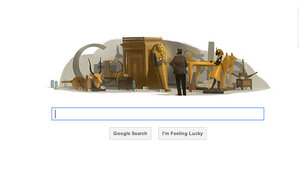Google Doodle: Howard Carter and the pharaoh's curse
When Howard Carter, the archaeologist honored by Wednesday's Google Doodle, discovered King Tut's tomb, he inadvertently sparked the myth of the pharaoh's curse. Howard Carter didn't believe in curses. Yet the false rumors persisted.

Howard Carter, an English archaeologist famous for discovering King Tut's tomb, is honored by Google with a doodle.
When archaeologist Howard Carter discovered the tomb of the pharaoh Tutankhamun, he may have anticipated he’d be bringing unprecedented knowledge about the Egyptian culture to the world. He probably didn’t realize he’d be bringing another cultural phenomenon as well: the superstition of a curse of the pharaohs.
Carter, an English archaeologist who began working in Egypt when he was 17, became primarily known for his discovery of the tomb of the young pharaoh Tutankhamun in 1922. The artifacts discovered in the tomb and various lectures that Carter delivered about his discoveries were largely responsible for America's sudden interest in Egyptology. Because of his stature in the archaeological community, Carter has often been represented in fiction, becoming a key character in the popular "Amelia Peabody's Egypt" mystery series by Elizabeth Peters and “The Tutankhamun Affair” by Christian Jacq, as well as being portrayed by actor Pip Torrens in the “Young Indiana Jones” TV series and by John Cleese as part of a Monty Python sketch.
The idea that those who opened a pharaoh’s tomb were cursed did not originate with Howard Carter and the opening of King Tut’s resting place. In fact, various short stories, including one by author Louisa May Alcott, had appeared before then using the device of a mummy coming back to life.
However, a series of tragedies that befell those who were involved in the opening of Tutankhamun’s tomb sparked media coverage and gave rise to the superstition that that some mystical curse had affected those who had dared disturb the tomb. The first incident supposedly occurred when a pet canary kept by Carter was found dead in its cage, attacked and killed by a cobra. A cobra was often a symbol for the rulers of Egypt.
“The incident made an impression on the native staff, who regard it as a warning from the spirit of the departed King against further intrusion on the privacy of his tomb,” wrote a New York Times reporter at the time. However, the veracity of this story – whether the canary died or was ever even attacked by a cobra – has been called into question.
Rumors of the curse came to America through an author named Marie Corelli, who had a letter published in the newspaper the New York World in which she stated that she was concerned by the opening of King Tut’s tomb. Corelli quoted a book she said she owned called “The Egyptian History of the Pyramids,” which she said stated, “The most dire punishment follows any rash intruder into a sealed tomb.”
“The book names 'secret poisons enclosed in boxes in such wise that those who touch them shall not know how they come to suffer,' wrote Corelli. "That is why I ask, Was it a mosquito bite that has so seriously infected [Carter's financial backer] Lord Carnarvon?”
The furor increased when several other people who had been present at the tomb when it was opened, or later visited it, died over the next few years. Four other people died the year after the tomb was opened, including Egyptian Prince Ali Kahmel Falim Bey and British diplomat Colonel Aubrey Herbert.
However, none of these deaths were classified as unexplained or mysterious – Bey was killed by his wife, Herbert died after a botched dental procedure, and the other two who died in the year after the tomb was open, George Jay Gould and Woolf Joel, died of a fever and a gunshot wound, respectively.
Reportedly Carter gave a friend of his, Sir Bruce Ingram, a mummified hand with a bracelet on it to use as a paperweight. Ingram said that soon after accepting the gift, his house burned down, was subsequently rebuilt, and then sustained damage in a flood.
Some other Egyptian tombs referred to supposed curses, including one in the tomb of a vizier, Khentika Ikhekhi. The hieroglyphs read, “As for all men who shall enter this my tomb... impure... there will be judgment... an end shall be made for him... I shall seize his neck like a bird... I shall cast the fear of myself into him.”
No such inscriptions were found in the tomb of King Tut.
It's worth noting that Carter never believed in the superstition. He died more than a decade after opening the tomb.
Despite naysayers, the idea of cursed mummies who rise from the dead continues to live on in popular imagination. Walking mummies were a regular feature in the Scooby-Doo cartoons that originally began airing in the 1960s, and a 1932 film simply titled “The Mummy,” starring Boris Karloff as the title character followed a group of archaeologists who accidentally woke a dead pharaoh. The movie was remade into a 1999 film of the same name starring Brendan Fraser that spawned two sequels, and another is planned.
For more tech news, follow us on Twitter @venturenaut.

